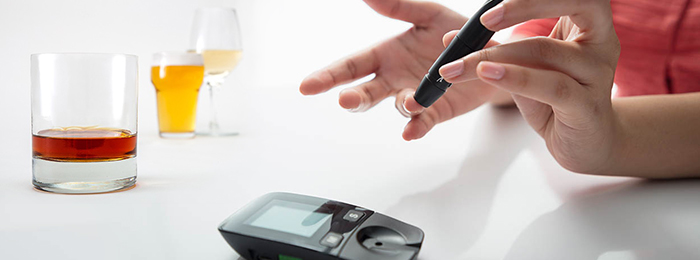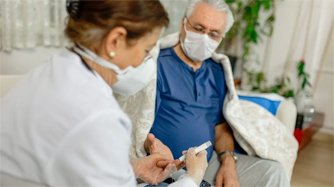Mark Twain, the famous American author and humourist, is supposed to have said, “Giving up smoking is the easiest thing in the world. I know because I’ve done it thousands of times.” Any kind of addiction usually falls into a pattern of trying to abstain, start again, give up again and so on.
Alcoholism and diabetes are both known to be chronic conditions and need to be dealt with appropriately to help in diabetes management. If not managed well, they can lead to complications, poor quality of life and can even be fatal. Alcoholism can interfere with diabetes management, whether you have Type 1 diabetes or Type 2 diabetes.
How does drinking alcohol affect diabetes and related conditions?
Liver processes alcohol. When one consumes alcohol in excess, its ability to release glucose is hampered, as the liver wants to get rid of the alcohol. Hence, it lowers sugar levels, putting one at risk of hypoglycemia and complications. Alcohol also stimulates your appetite, causing you to over-eat and lower sugar control.
Other effects of alcohol:
- Beer and sweet wine contain carbohydrates that raise sugars.
- Alcohol also increases triglyceride levels.
- Affects liver.
- Can cause nausea, flushing, slurring of speech, and increased heart rate.
- Increases rate of heart attack and stroke with diabetes.
Symptoms of intoxication and hypoglycemia are similar – dizziness, disorientation and fatigue. Alcohol can worsen diabetes complications and cause disturbances in fat metabolism which worsens nerve damage and eye-disease.
What precautions do I need to take?
Never consume alcohol on an empty stomach.
If you are a Type 1 diabetic, it is advisable to stop consuming alcohol, or at least check blood sugar levels and decrease insulin dosage at that time. If you are a type 2 diabetic, it is advisable to ask your doctor about the timing of alcohol consumption and diabetic medication, as those who take metformin are at risk for liver complications when combined with liquor.
If you must drink, only drink occasionally, and when your diabetes and blood sugars are well controlled.
How much can I drink?
- Can increase BP.
- If you already have neuropathy, alcohol worsens and increases the pain, tingling and numbness.
- 12 oz of beer, or
- 5 oz of wine, or
- A single shot of liquor (1 ½ oz).
Recommended doses are 40 gms (4 standard drinks for men) and 20 gms (2 standard drinks for women), i.e. 28 and 14 drinks, respectively, per week, is the upper limit of low risk use. There should also be 2 or 3 alcohol free days each week.
Alcohol dependence and abuse:
Alcoholism does not simply relate to the amount one drinks, but starts when an individual is controlled by the need to drink, rather than being in control of their alcohol consumption. When the body becomes tolerant to the same quantity and one has to increase consumption to get the same effect, one is reaching the danger zone. Alcoholism is the most severe form of alcohol abuse. Like diabetes, it is a chronic disease that interferes with physical and mental well-being.
It is important to note that alcohol abuse differs from alcohol dependence, by the presentation of symptoms given below; (there should be at least three or more of the following criteria over a 12- month period)
- Tolerance
- Withdrawal symptoms
- Persistent desire or unsuccessful efforts to cut down alcohol use
- Time is spent obtaining alcohol or recovering from its effects
- Social, occupational & recreational pursuits are given up or reduced because of alcohol abuse
- Persistent use despite knowledge of alcohol-related problems (psychological or physiological).
Alcohol and psychosocial issues:
Alcohol problems affect patients and their families, especially a child or spouse, who may become victims of physical and mental abuse and even develop anxiety or depression. The patients themselves may develop medical (gastritis, neuropathy, pancreatitis, etc), and psychiatric (paranoia, withdrawal delirium, suicide, etc) problems. Alcohol dependence needs treatment, through detoxification and withdrawal from alcohol, for at least a six month period, and relapse prevention strategies thereafter.
Are there any tests for detecting harmful effects of alcohol?
Several clinical tests may be useful in detecting harmful alcohol use such as an elevated gamma-glutamyl transpeptidase (GGT – liver function test) and raised mean corpuscle volume (MCV – Hematologic testing). However, results will be more discriminate, when combined with self-reports, interviews and questionnaires, rather than rely on biochemical markers only.
Here is a simple screening test called CAGE:
Over the past 12 months have you ever felt:
- You should CUT down on your drinking?
- ANNOYED by anyone commenting on your drinking?
- GUILTY about your drinking?
- You needed an EYE – OPENER to get started?
- If you receive two or more positives, you need a detailed alcohol work-up.
Where can I get help?
Alcoholics Anonymous can be a very important source of support and recovery for some patients for whom this approach is acceptable. Hazardous or harmful alcohol use, like all health related habits, tends to recur and needs regular follow-ups, for at least 12 to 18 months, to avoid relapse. Lastly, like we say about diabetes, it is important to control one’s diabetes to prevent health problems in the future. Similarly, it is important to control one’s drinking, rather than let it control you, for a better quality of life.




